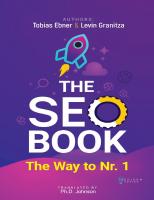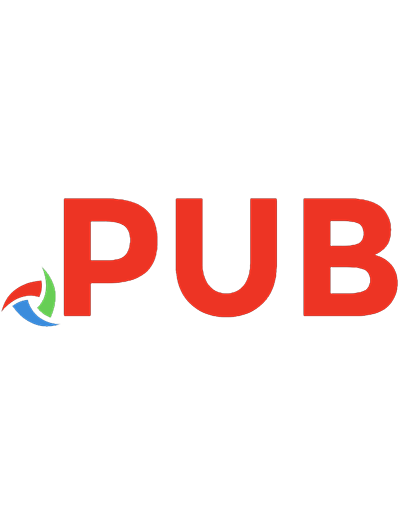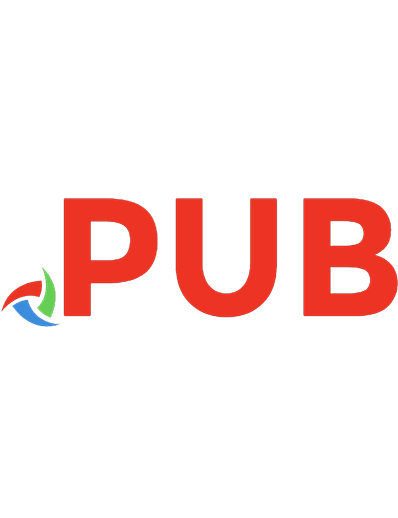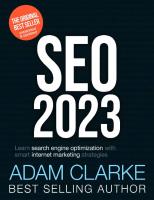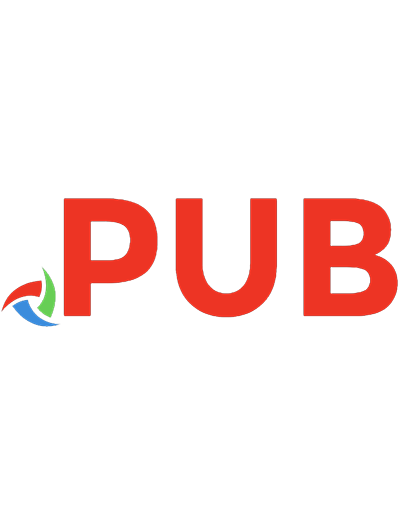The Art of SEO: Mastering Search Engine Optimization [4 ed.] 1098102614, 9781098102616
Three acknowledged experts in search engine optimization share guidelines and innovative techniques that will help you p
284 128 33MB
English Pages 773 Year 2023
![The Art of SEO: Mastering Search Engine Optimization [4 ed.]
1098102614, 9781098102616](https://dokumen.pub/img/200x200/the-art-of-seo-mastering-search-engine-optimization-4nbsped-1098102614-9781098102616.jpg)
- Author / Uploaded
- Eric Enge
- Stephan Spencer
- Jessie Stricchiola
- Categories
- Business
- Marketing: Advertising
- Commentary
- Revision History for the First Release: 2023-08-30: First Release.
Table of contents :
Foreword
Preface
Who This Book Is For
How This Book Is Organized
Why Us?
Conventions Used in This Book
O’Reilly Online Learning
How to Contact Us
Acknowledgments
1. Search: Reflecting Consciousness and Connecting Commerce
Is This Book for You?
SEO Myths Versus Reality
The Mission of Search Engines
Goals of Searching: The User’s Perspective
Determining User Intent: A Challenge for Search Marketers and Search Engines
Navigational Queries
Informational Queries
Transactional Queries
Local Queries
Searcher Intent
How Users Search
How Search Engines Drive Ecommerce
Types of Search Traffic
Search Traffic by Device Type
More on the Makeup of SERPs
The Role of AI and Machine Learning
Using Generative AI for Content Generation
SEO as a Career
Conclusion
2. Generative AI and Search
A Brief Overview of Artificial Intelligence
More About Large Language Models
Generative AI Solutions
Generative AI Capabilities
Prompt Generation (a.k.a. Prompt Engineering)
Generative AI Challenges
Conclusion
3. Search Fundamentals
Deconstructing Search
The Language of Search
Word Order and Phrases
Search Operators
Vertical and Local Intent
Crawling
The Index
The Knowledge Graph
Vertical Indexes
Private Indexes
The Search Engine Results Page
Organic Results
Special Features
Query Refinements and Autocomplete
Search Settings, Filters, and Advanced Search
Ranking Factors
Relevance
AI/Machine Learning’s Impact on Relevance
EEAT
Local Signals and Personalization
Timing and Tenure
Legitimacy
Source Diversity
Keywords in Anchor Text
Negative Ranking Factors
User Behavior Data
Conclusion
4. Your SEO Toolbox
Spreadsheets
Traffic Analysis and Telemetry
Google Search Console
Server-Side Log Analysis
JavaScript Trackers
Tag Managers
Search Engine Tools and Features
Autocomplete
Google Ads Keyword Planner
Google Trends
Google News
Related
Search Operators
SEO Platforms
Semrush
Ahrefs
Searchmetrics
Moz Pro
Rank Ranger
Other Platforms
Automation
YouTube Optimization
Conclusion
5. SEO Planning
Strategy Before Tactics
The Business of SEO
Ethical and Moral Considerations
The Escape Clause
Deciding on Accepting Work
Typical Scenarios
Startups (Unlaunched)
Startups (Launched)
Established Small Businesses
Large Corporations
Initial Triage
Document Previous SEO Work
Look for Black Hat SEO Efforts
Watch for Site Changes That Can Affect SEO
Identify Technical Problems
Know Your Client
Take Inventory of the Client’s Relevant Assets
Perform a Competitive Analysis
Information Architecture
SEO Content Strategy
The Long Tail of Search
Examples of Sites That Create Long-Tail Content
Why Content Breadth and Depth Matter
Can Generative AI Solutions Help Create Content?
Measuring Progress
Conclusion
6. Keyword Research
The Words and Phrases That Define Your Business
The Different Phases of Keyword Research
Expanding Your Domain Expertise
Building Your Topics List
Preparing Your Keyword Plan Spreadsheet
Internal Resources for Keyword Research
Web Logs, Search Console Reports, and Analytics
Competitive Analysis
People
External Resources for Keyword Research
Researching Natural Language Questions
Researching Trends, Topics, and Seasonality
Keyword Valuation
Importing Keyword Data
Evaluating Relevance
Priority Ratings for Business Objectives
Filtering Out Low-Traffic Keywords
Breaking Down High-Difficulty Keywords
Trending and Seasonality
Current Rank Data
Finding the Best Opportunities
Acting on Your Keyword Plan
Periodic Keyword Reviews
Conclusion
7. Developing an SEO-Friendly Website
Making Your Site Accessible to Search Engines
Content That Can Be Indexed
Link Structures That Can Be Crawled
XML Sitemaps
Creating an Optimal Information Architecture
The Importance of a Logical, Category-Based Flow
Site Architecture Design Principles
Flat Versus Deep Architecture
Search-Friendly Site Navigation
Root Domains, Subdomains, and Microsites
When to Use a Subfolder
When to Use a Subdomain
When to Use a Separate Root Domain
Microsites
Selecting a TLD
Optimization of Domain Names/URLs
Optimizing Domains
Picking the Right URLs
Keyword Targeting
Title Tags
Meta Description Tags
Heading Tags
Document Text
Image Filenames and alt Attributes
Visual Search
Boldface and Italicized Text
Keyword Cannibalization
Keyword Targeting in CMSs and Automatically Generated Content
Effective Keyword Targeting by Content Creators
Long-Tail Keyword Targeting
Content Optimization
Content Structure
CSS and Semantic Markup
Content Uniqueness and Depth
Content Themes
Duplicate Content Issues
Consequences of Duplicate Content
How Search Engines Identify Duplicate Content
Copyright Infringement
Example Actual Penalty Situations
How to Avoid Duplicate Content on Your Own Site
Controlling Content with Cookies and Session IDs
What’s a Cookie?
What Are Session IDs?
How Do Search Engines Interpret Cookies and Session IDs?
Why Would You Want to Use Cookies or Session IDs to Control Search Engine Access?
Content Delivery and Search Spider Control
Cloaking and Segmenting Content Delivery
Reasons for Showing Different Content to Search Engines and Visitors
Leveraging the robots.txt File
Using the rel=“nofollow” Attribute
Using the Robots Meta Tag
Using the rel=“canonical” Attribute
Additional Methods for Segmenting Content Delivery
Redirects
Why and When to Redirect
Good and Bad Redirects
Methods for URL Redirecting and Rewriting
How to Redirect a Home Page Index File Without Looping
Using a Content Management System
CMS Selection
Third-Party CMS or Ecommerce Platform Add-ons
CMS and Ecommerce Platform Training
JavaScript Frameworks and Static Site Generators
Types of Rendering
JavaScript Frameworks
Jamstack
Problems That Still Happen with JavaScript
Best Practices for Multilingual/Multicountry Targeting
When to Enable a New Language or Country Version of Your Site
When to Target a Language or Country with a Localized Website Version
Configuring Your Site’s Language or Country Versions to Rank in Different Markets
The Impact of Natural Language Processing
Entities
Fair Use
Structured Data
Schema.org
Schema.org Markup Overview
How to Use Schema.org
Summarizing Schema.org’s Importance
Google’s EEAT and YMYL
Author Authority and Your Content
Why Did Google End Support for rel=“author”?
Is Author Authority Dead for Google?
Author Authority and EEAT
Author Authority Takeaways
Google Page Experience
Use of Interstitials and Dialogs
Mobile-Friendliness
Secure Web Pages (HTTPS and TLS)
Core Web Vitals
How Much of a Ranking Factor Are Core Web Vitals?
Using Tools to Measure Core Web Vitals
Optimizing Web Pages for Performance
Approach to Rendering Pages
Server Configuration
Ecommerce/CMS Selection and Configuration
Analytics/Trackers
User Location and Device Capabilities
Domain Changes, Content Moves, and Redesigns
The Basics of Moving Content
Large-Scale Content Moves
Mapping Content Moves
Expectations for Content Moves
Maintaining Search Engine Visibility During and After a Site Redesign
Maintaining Search Engine Visibility During and After Domain Name Changes
Changing Servers
Changing URLs to Include Keywords in Your URL
Accelerating Discovery of Large-Scale Site Changes
Conclusion
8. SEO Analytics and Measurement
Why Measurement Is Essential in SEO
Analytics Data Utilization: Baseline, Track, Measure, Refine
Measurement Challenges
Analytics Tools for Measuring Search Traffic
Valuable SEO Data in Web Analytics
Referring Domains, Pages, and Sites
Event Tracking
Connecting SEO and Conversions
Attribution
Segmenting Campaigns and SEO Efforts by Conversion Rate
Increasing Conversions
Calculating SEO Return on Investment
Diagnostic Search Metrics
Site Indexing Data
Index-to-Crawl Ratio
Search Visitors per Crawled Page
Free SEO-Specific Analytics Tools from Google and Bing
Using GA4 and GSC Together
Differences in How GA4 and GSC Handle Data
Differences Between Metrics and Dimensions in GA4 and GSC
First-Party Data and the Cookieless Web
Conclusion
9. Google Algorithm Updates and Manual Actions/Penalties
Google Algorithm Updates
BERT
Passages and Subtopics
MUM
Page Experience and Core Web Vitals
The Link Spam Update
The Helpful Content Update
Broad Core Algorithm Updates
Functionality Changes
Google Bug Fixes
Google Search Console
Google Webmaster Guidelines
Practices to Avoid
Good Hygiene Practices to Follow
Quality Content
Content That Google Considers Lower Quality
The Importance of Content Diversity
The Role of Authority in Ranking Content
The Impact of Weak Content on Rankings
Quality Links
Links Google Does Not Like
Cleaning Up Toxic Backlinks
Sources of Data for Link Cleanup
Using Tools for Link Cleanup
The Disavow Links Tool
Google Manual Actions (Penalties)
Types of Manual Actions/Penalties
Security Issues
Diagnosing the Cause of Traffic/Visibility Losses
Filing Reconsideration Requests to Remediate Manual Actions/Penalties
Recovering from Traffic Losses Not Due to a Manual Action/Penalty
Conclusion
10. Auditing and Troubleshooting
SEO Auditing
Unscheduled Audits
Customized Approaches to Audits
Pre-Audit Preparations
Additional SEO Auditing Tools
Core SEO Audit Process Summary
Sample SEO Audit Checklist
Auditing Backlinks
SEO Content Auditing
Troubleshooting
Pages Not Being Crawled
Page Indexing Problems
Duplicate Content
Broken XML Sitemaps
Validating Structured Data
Validating hreflang Tags
Local Search Problems
Missing Images
Missing alt Attributes for Images
Improper Redirects
Bad or Toxic External Links
Single URL/Section Ranking/Traffic Loss
Whole Site Ranking/Traffic Loss
Page Experience Issues
Thin Content
Poor-Quality Content
Content That Is Not Helpful to Users
Google Altering Your Title or Meta Description
Hidden Content
Conclusion
11. Promoting Your Site and Obtaining Links
Why People Link
Google’s View on Link Building
How Links Affect Traffic
Finding Authoritative, Relevant, Trusted Sites
Link Analysis Tools
Identifying the Influencers
Determining the Value of Target Sites
Creating a Content Marketing Campaign
Discuss Scalability
Audit Existing Content
Seek Organically Obtained Links
Researching Content Ideas and Types
Articles and Blog Posts
Videos
Research Reports, Papers, and Studies
Interactives
Collaborations with Other Organizations
Collaborations with Experts
Quizzes and Polls
Contests
Cause Marketing
Comprehensive Guides and In-Depth Content Libraries
Infographics
Tools, Calculators, or Widgets
Viral Marketing Content
Memes
Content Syndication
Social Media Posts
Creating Remarkable Content
Hiring Writers and Producers
Generating and Developing Ideas for Content Marketing Campaigns
Don’t Be a Troll
Don’t Spam, and Don’t Hire Spammers
Relationships and Outreach
Building Your Public Profile
Link Reclamation
Link Target Research and Outreach Services
Qualifying Potential Link Targets
The Basic Outreach Process
What Not to Do
Outbound Linking
Conclusion
12. Vertical, Local, and Mobile SEO
Defining Vertical, Local, and Mobile Search
Vertical Search
Local and Mobile Search
The Impact of Personalization
Journeys and Collections
How Local Is Local Search?
Vertical Search Overlap
Optimizing for Local Search
Where Are Local Search Results Returned?
Factors That Influence Local Search Results
Optimizing Google Business Profiles
Customer Reviews and Reputation Management
Understanding Your Local Search Performance
The Problem of Fake Competitors
Common Myths of Google Business Profile Listings
Optimizing On-Site Signals for Local
Optimizing Inbound Links for Local
Optimizing Citations for Local
Structured Data for Google Business Profile Landing Pages
Image Search
Image Optimization Tips
Image Sharing Sites
News Search
Google News
Measuring News Search Traffic
Video Search
YouTube
Google Videos and Universal Search
Conclusion
13. Data Privacy and Regulatory Trends
The Consumer Data Privacy Revolution
The IAB Sounds the Alarm
Privacy Legislation Overview
Third-Party Cookie Deprecation
Google’s Privacy Sandbox
Google’s Topics API
Google’s Protected Audience API
Google Analytics 4
Apple’s Consumer-Friendly Privacy Shift
Conclusion
14. SEO Research and Study
SEO Research and Analysis
SEO Forums
Websites
Subreddits and Slack Channels
Resources Published by Search Engines
Interpreting Commentary
SEO Testing
Analysis of Top-Ranking Sites and Pages
Analysis of Algorithmic Differences Across Various Search Platforms
The Importance of Experience
Competitive Analysis
Content Analysis
Internal Link Structure and Site Architecture
External Link Attraction Analysis
SEO Strategy Analysis
Competitive Analysis Summary
Using Competitive Link Analysis Tools
Using Search Engine–Supplied SEO Tools
Google Search Console
Bing Webmaster Tools
The SEO Industry on the Web
Social Networks
Conferences and Organizations
SEO and Search Marketing Training
Conclusion
15. An Evolving Art Form: The Future of SEO
The Ongoing Evolution of Search
The Growth of Search Complexity
Natural Language Processing
Entities and Entity Maps
Meeting Searcher Intent
More Searchable Content and Content Types
Crawling Improvements
New Content Sources
More Personalized and User-Influenced Search
User Experience
Growing Reliance on the Cloud
Increasing Importance of Local, Mobile, and Voice Search
Local Search
Voice Is Just a Form of Input
Increased Market Saturation and Competition
SEO as an Enduring Art Form
The Future of Semantic Search and the Knowledge Graph
Conclusion
Index
About the Authors

![The Art of SEO: Mastering Search Engine Optimization [4 ed.]
1098102614, 9781098102616](https://dokumen.pub/img/200x200/the-art-of-seo-mastering-search-engine-optimization-4nbsped-1098102614-9781098102616-v-4590168.jpg)

